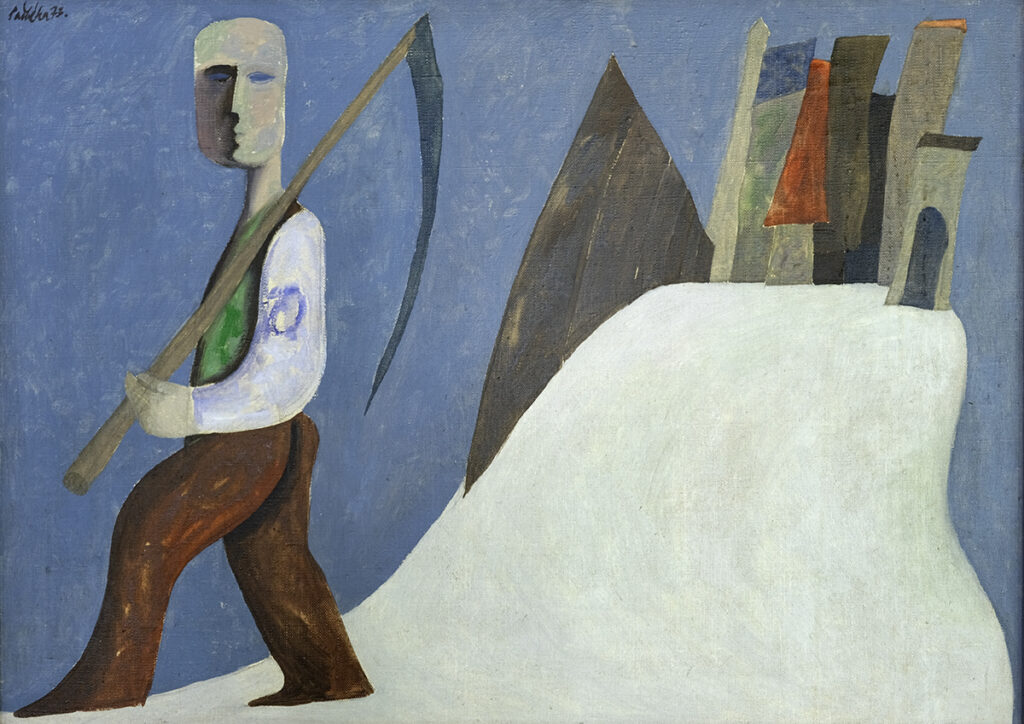Paštéka’s whole creative program is based on his inspiration with countryside, natural environment and landscapes, which he had a close relationship with as it was where he grew up and spent a part of his life. The painting of Man with a Scythe is set in an outlined mountain region with rural architecture in the right part of the image. He balanced it compositionally with a monumental and robust figure of a man with a scythe. His figure is simplified to individually coloured areas, the hands are positioned into the shape of wings, which he later favoured a lot. The whole image is set into a neutral blue and grey background. Colour is an important part of his images, it formed their space, light and atmosphere, it is their emotional element. The flat and simple properties of the image are in contrast with the man’s head and face which seems to have a disturbing effect upon closer inspection. The artist used an interesting approach when he painted a single face with two different looks – a face from the front and in profile. He incorporated two faces into one, as if he wanted to mediate two different world views, one from the outside and one from the inside. Iva Mojžišová described the painter as “… a painter of his own human experience.”1 Paštéka very deeply contemplated human life, human existence and the world of mankind. His work does not aspire to be a generalising witness to history, but rather a subjective view of himself. He uses an empirical approach to his work. He depicts his own experiences and tries to understand this world through self-exploration, self-realisation and introspection.
Milan Paštéka entered the art scene at the turn of the 1950s and 1960s. He was one of the most important figures of the 20th century. Even though some theorists consider him a representative of new figuration in Slovakia (e.g. Váross), it is based mostly on Paštéka’s inspiration by European painters in terms of thought processes rather than the actual visual properties of their images, which had not manifested that much in his language. The artist was much more solitary and due to his unique language he was de facto “unclassifiable”. The artist’s painting style did not develop linearly. In his work, he would switch between abstract depictions and figures and then back to abstraction. In Paštéka’s final creative stage, he started leaning toward non-figurative expressions. He would use different media, mostly drawing and painting. In 1957, he became a co-founder of the Mikuláš Galanda Group, which was founded as an opposition to the dogmatic social realism with the intention of following the traditions of national modernism of the 1930s, mostly the works of Mikuláš Galanda, but also Miloš Bazovský and Ľudovít Fulla. Up until it was terminated in 1968, the group had made a substantial imprint on the domestic art scene. In 1972, together with other members of the Mikuláš Galanda Group, Paštéka’s work was criticised in the anthology For Socialist Art (Materials From Meetings of Art Associations, Slovenský spisovateľ [Slovak Writer], 1972) and he was subsequently expelled from the Association of Slovak Fine Artists, which had a devastating effect on the artist in terms of him not being able to exhibit anymore. After the artist’s first solo exhibition at Cyprián Majerník Gallery in 1958 was banned, Milan Paštéka’s first solo exhibition was held much later at Bratislava City Gallery in 1965, but it was also heavily criticised. The artist returns to the official art scene only in the late 1980s.
Milan Paštéka was born in Trenčín in 1931, he died in a tragic car accident in Voznica, near Žiar nad Hronom in 1998. Between 1950 – 1955, he studied at the Academy of Fine Arts and Design in Bratislava at the studios of prof. Fulla and prof. Želibský. In 1966, he received the Cyprián Majerník Award and in 1999, the Martin Benka Award in memoriam. The importance of his work reaches international dimensions, he participated at many important exhibitions abroad, he represented Slovakia at the Venice Biennials in 1990.
— Barbora Kurek Geržová
Notes
1 Mojžišová, Iva: Giacomettiho oko a iné texty zo šesťdesiatych rokov [Giacometti’s Eye and Other Important Texts From the 1960s]. Bratislava: Vydavateľstvo A F s. r. o, 1994, p. 150.
Bibliography
Mojžišová, Iva: Giacomettiho oko a iné texty zo šesťdesiatych rokov [Giacometti’s Eye and Other Important Texts From the 1960s]. Bratislava: Vydavateľstvo A F s. r. o, 1994, p. 150.
Kol. autorov: Šesťdesiate roky v slovenskom výtvarnom umení [Collective of Authors: The 1960s in Slovak Fine Art]. Bratislava: SNG, 1995.
Kol. autorov [Collective of Authors]: Milan Paštéka. Koloman Kertész Bagala, Vydavateľstvo L. C. A. Levice, 2001.
Mojžiš, Juraj: Milan Paštéka. Uhol odvahy [Milan Paštéka. An Angle of Courage]. Bratislava: Galéria Nedbalka, 2013.
Inventory No.: O 804
Artist: Milan Paštéka
Title: Man With a Scythe
Year of origin: 1973
Technique: oil
Material: canvas
Dimensions: 50 × 70 cm
Signature: top right Paštéka 73
